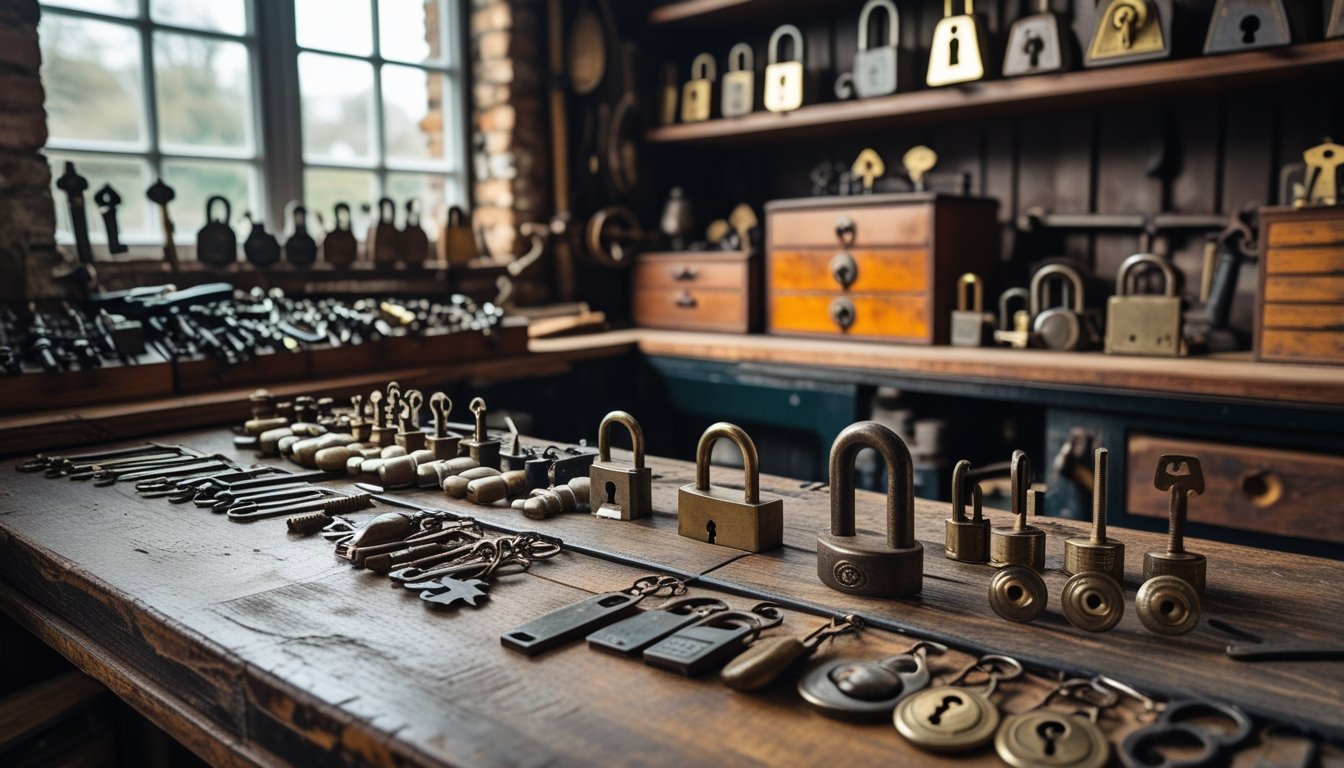Late updated: 17 Sep 2025 14:09
Written by: Elena Prescott
Unlocking The Past A Journey Through UK Locksmith History: Exploring The Craft's Evolution
Unlocking the history of locksmithing in the UK offers a fascinating glimpse into the past. The profession is rooted in ancient traditions, starting with rudimentary wooden locks, which laid the foundation for the locksmithing craft as we know it. The story of UK locksmithing is one of continuous adaptation and evolution, showcasing human ingenuity in the face of growing security needs.

From the medieval period, when locksmiths were regarded as artisans due to their work on intricate and elaborate locks for cathedrals and palaces, to the modern age of digital security systems, locksmithing has always been at the forefront of technological advancement. Today, these advancements not only highlight a rich history but also underscore the crucial role locksmiths play in contemporary society in safeguarding assets.
As we take this journey through the evolution of locksmithing in the UK, we will explore both historical milestones and modern innovations. Our exploration will provide insights into how this age-old profession has shaped and responded to the distinct security challenges through the centuries, offering valuable context for understanding contemporary practices.
Key Takeaways
- UK locksmithing has ancient roots with ongoing evolution to meet security needs.
- Locksmiths have progressed from crafting ornate locks to integrating digital security.
- The profession remains vital in maintaining security standards today.
The Origins and Historical Milestones of UK Locksmithing

Our exploration of the history of locksmithing in the UK takes us from the ancient civilisations with their wooden locks to the ingenuity of the Roman and Medieval periods. We also look at the development of warded and pin tumbler locks and the transformative influence of the Industrial Revolution, culminating in the creation of the Yale Lock.
Ancient Civilisations and the Birth of Locks
Locksmithing's roots can be traced back to ancient Egypt where, about 4,000 years ago, craftsmen designed the earliest known locks. These initial wooden locks were surprisingly intricate, utilising a pin tumbler mechanism. Pins of various lengths inside the lock required manipulation to permit the bolt to move and open the door. This fundamental concept of securing access by aligning pins remains integral to some locks today.
In these early times, locks were luxury items, used primarily to protect valuable possessions. As ideas of personal property and security evolved, so did the complexity and intricacy of locking mechanisms. The evolution from these humble beginnings set the stage for future innovations and adaptations across empires and eras.
Roman and Medieval Locksmithing Innovations
The Romans further advanced the field of locksmithing by introducing metalwork into lock construction. Their innovations included locks with multiple levers and sophisticated wards—the latter being obstacles inside the lock designed to block the wrong key. Roman locks were more compact and portable, leading to the famous usage of padlocks.
During the Medieval period, locksmiths continued to innovate, creating more intricate and ornate locks. Castles, cathedrals, and wealthy estates had custom-designed locks that not only offered enhanced security but also served as a display of craftsmanship. This period marked a significant evolution with locksmiths becoming specialised artisans, known as experts within their communities.
The Rise of Warded and Pin Tumbler Locks
Warded locks, prominent in the distribution of secure locking mechanisms during the Middle Ages, used series of obstacles to exclude all but the correct key. These locks provided a robust yet simplistic solution, but were eventually outpaced by the more secure pin tumbler lock.
Inventors developed the pin tumbler lock—a revolutionary improvement. This design, initially made from wood, was refined over time and offered a significant step forward in security technology. The pin tumbler lock's reliance on a series of moving pins disturbed by the unique shape of a key enhanced protection, bringing a new era of secure and reliable locks.
The Industrial Revolution and the Emergence of the Yale Lock
The Industrial Revolution marked a turning point. Mass production techniques began to shape locksmithing, increasing availability and variety of locks. The Yale Lock, invented by Linus Yale Jr., represented a mix of the industrial process and centuries of locksmithing wisdom. This lock used a small, flat key and represented a major technological leap, integrating the pin tumbler mechanism more effectively with increased security features.
This period also saw the development of the modern padlock, conveniently enhancing security for portable applications. Locksmiths were now required to adapt quickly to evolving technologies, offering solutions that catered to new industrial and personal security needs. The innovations of the Industrial Revolution set the foundations for modern locksmithing practices we depend on today.
Modern Advances and the Evolution of UK Locksmithing
Recent advancements have drastically changed locksmithing in the UK. The transition from mechanical locks to electronic and smart lock systems has revolutionised security solutions. Professionalisation within the industry has also elevated service standards.
Professionalisation of Locksmiths in the UK
The locksmithing profession in the UK has seen significant strides towards standardisation and professionalisation. Organisations such as the Master Locksmiths Association (MLA) play an essential role. They set rigorous training and conduct standards, ensuring that locksmiths provide reliable and trustworthy services.
With the rise in burglaries and security threats, the demand for professional locksmiths has surged. Our locksmiths are trained in complex lock mechanisms and digital security, making them indispensable for modern home security. By professionalising, locksmiths earn increased trust from clients and contribute to raising industry standards.
Technological Innovations: Electronic and Smart Locks
Electronic and smart locks have reshaped the landscape of security systems. These innovations offer a level of convenience and security previously unattainable with traditional locks. Keyless entry systems and electronic locks are now standard, providing enhanced security and user-friendly experience.
Smart locks can be operated remotely, allowing homeowners to manage access using smartphones or other digital devices. This technology assures modern security needs and presents alternatives to conventional locks. As a result, our approach to securing residential and commercial properties has evolved, providing innovative lock mechanisms that address contemporary threats effectively.
Contemporary Security Systems and Solutions
In today's security landscape, comprehensive systems and solutions cater to various needs, from residential to commercial properties. We deploy advanced security systems that integrate CCTV, alarms, and digital access control. This integration offers a holistic approach to home and business security.
Our focus on contemporary security solutions involves an understanding of both lock repair and installation of state-of-the-art digital security systems. By staying at the forefront of technological advancements, locksmiths in the UK ensure robust security solutions tailored to individual needs. Such systems are crucial for protecting assets and personal safety in a rapidly changing world.
Frequently Asked Questions

In this section, we explore key milestones in the evolution of locksmithing in the UK, the transformation of the locksmith's role during industrial changes, and significant British contributions to lock-making innovations.
What are the milestones in the development of locksmithing in the UK?
Locksmithing in the UK has a storied history marked by pivotal moments. The introduction of mechanical locks in the medieval period and the later development of lever and tumbler mechanisms were crucial. The advent of digital locks further revolutionised the industry, highlighting the UK's adaptability to new technologies.
How did the role of locksmiths evolve during the industrial revolution in Britain?
The industrial revolution significantly altered the locksmith profession. Mass production meant traditional artisans shifted towards roles in lock repair and key duplication. This era saw locksmiths specialising in specific areas, such as industrial lock design and maintenance, reflecting broader changes in societal needs and technological advancements.
What notable advancements in lock-making can be traced back to British inventors?
British inventors have significantly contributed to lock-making. Noteworthy innovations include the double-acting lever tumbler lock by Joseph Bramah and the patenting of the Chubb detector lock. Both inventions were pivotal in enhancing security features and set new standards in lock design well into the modern era.
Which historical periods were significant for the growth of the locksmith industry in the UK?
Several periods have been vital to the locksmith industry's expansion. The Victorian era, with its focus on security and innovation, was particularly important. Post-war Britain also saw a surge in demand for advanced security solutions, prompting further advancements in locksmithing techniques and technology.
How have British regulations and standards influenced the locksmith profession over time?
British regulations have consistently shaped the locksmith profession. The establishment of the Master Locksmiths Association set industry standards. Further regulations, including safety and quality codes, ensured that locksmiths adhered to best practices, thereby enhancing public trust and setting high benchmarks for the profession.
What impact did the Victorian era have on lock design and security features?
During the Victorian era, there was a heightened focus on secure households. This led to innovative lock designs, such as Chubb's detector lock, which offered unprecedented security. Intricate mechanisms and decorative hardware also became more prominent, indicating a merging of security with aesthetic appeal in lock design.
